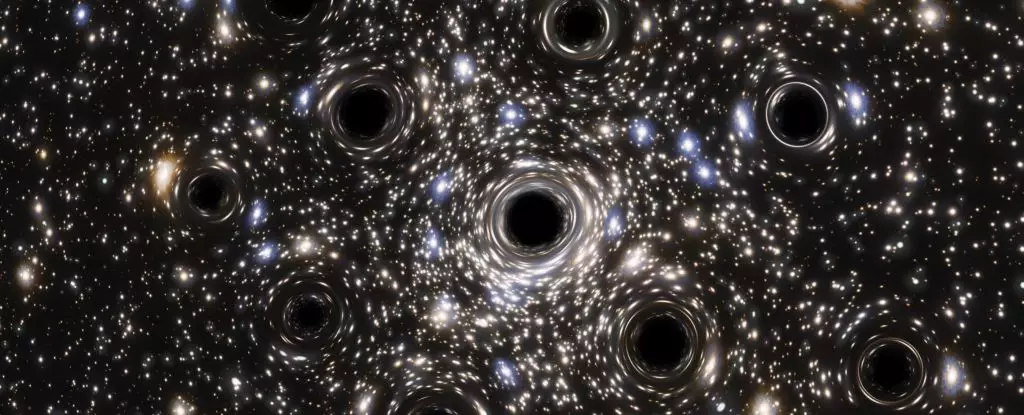Omega Centauri, one of the Milky Way’s most captivating cosmic beacons, presents a captivating mystery for astronomers and astrophysicists alike. Situated approximately 17,000 light-years from Earth, this massive globular cluster is a gravitationally bound collection of stars, estimated to number around 10 million. Known for its dense core and rich history, Omega Centauri is believed to be the remnant of a dwarf galaxy, which researchers have colloquially termed the Gaia Sausage, absorbed into the Milky Way galaxy eons ago. This fascinating cluster not only serves as a stellar nursery but also as a crucible for understanding the complex behavior of black holes.
Delving deeper into the cosmic narrative, researchers are particularly intrigued by the possibility of intermediate-mass black holes (IMBHs) dwelling within Omega Centauri’s depths. Unlike the well-documented supermassive black holes that inhabit galaxy centers or the smaller stellar-mass black holes originating from the collapse of massive stars, IMBHs occupy a largely uncharted territory. These black holes typically range from a few hundred to a million solar masses and represent the missing link between the two extremes of black hole types.
Astrophysicist Andrés Banáres Hernández from the Institute of Astrophysics of the Canary Islands articulates the conundrum well: “By studying Omega Centauri, we attempting to reveal the existence of IMBHs and examine their potential role in the evolution of stars and galaxies.” Understanding the nature and existence of IMBHs could not only illuminate the lifecycle of star clusters but help solve a debate that has persisted for more than two decades.
Historically, calculations regarding the mass hidden in Omega Centauri had pointed toward a singular, massive black hole estimated to have a mass thousands of times that of the Sun. However, recent findings complicate this narrative, suggesting instead an entire swarm of stellar-mass black holes. While this perspective may seem unconventional—given the gravitational dynamics and interactions that would typically send black holes careening out of a cluster’s core—it presents an intriguing new avenue for exploration.
A crucial study earlier this year estimated that there exists a mass approximating 8,200 solar masses within Omega Centauri, a figure aligning well with the characteristics expected of an IMBH. However, this finding does not merely confirm the presence of a single object; instead, it raises inquiries into the dynamics that keep stellar-mass black holes clustered together.
Adding a fascinating layer to the investigation, researchers have utilized pulsar data to enhance their analysis. Pulsars are rapidly rotating neutron stars that emit beams of radiation, creating a signature-pulsing effect visible from Earth. The precise nature of pulsar motion allows for incredibly accurate measurements, enabling scientists to glean insights into gravitational influences and motions within stellar systems.
Incorporating this data, Hernández and his team have proposed that the peculiar movement of stars within Omega Centauri may result from a dense swarm of stellar-mass black holes rather than a singular IMBH. Interestingly, this coexistence of smaller black holes alongside a potential IMBH is not only plausible but could also provide insights into the evolutionary pathways of such celestial entities. The gravity of an IMBH could indeed bind stellar-mass black holes, leading to a surprisingly stable configuration within the cluster.
The implications of these findings are rich and multifaceted. Understanding the potential interplay between stellar-mass black holes and intermediate-mass black holes can significantly contribute to broader theories regarding galaxy formation and evolution. It raises pivotal questions: Could these stellar-mass black holes be building blocks for the formation of larger black holes over cosmic time? How do these processes impact the behavior of their surrounding stellar populations?
As the hunt for IMBHs in Omega Centauri and beyond continues, astronomers remain optimistic that advancements in observational technology and analytics will soon yield clearer insights. As they grapple with the enigma of the universe’s unseen mass, each revelation brings them closer to comprehensively understanding the complexities of black holes and their role in the grand cosmos.
Omega Centauri doesn’t merely invite astronomers to look; it beckons them to question and explore. As the boundaries of knowledge in astrophysics expand, every discovery, particularly those involving the elusive IMBHs, potentially reshapes our understanding of space and time. The gravitational dance of black holes in this mesmerizing star cluster promises to deepen our comprehension of cosmic origins and the universe’s fateful architecture. Each study, each mathematical model brings us one step closer to demystifying the enigmatic entities lurking in the darkness of the cosmos, forever guiding our quest for understanding the universe we inhabit.


Leave a Reply